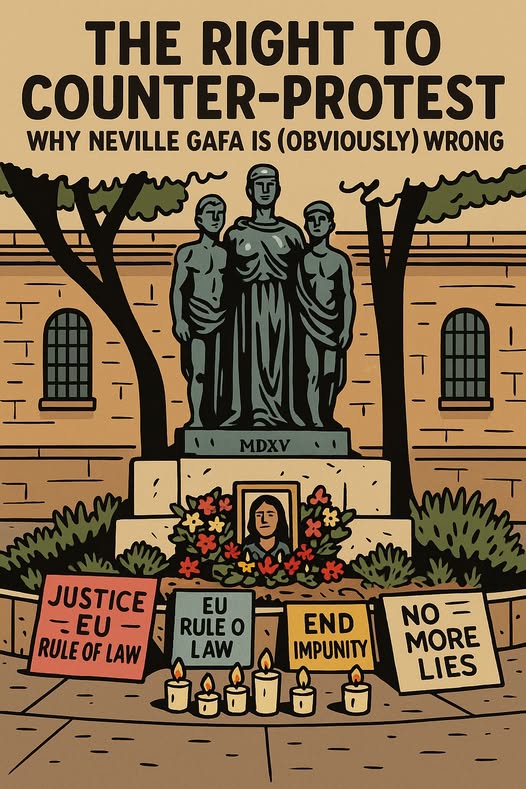« On day 18 of the trial of those charged with supplying the bomb that killed Daphne Caruana Galizia, as her family sit in court listening to every unbearable detail of the plot, out here in Great Siege Square, lowlife cowards continue to try to destroy Daphne’s memory and our protest for justice. » – Occupy Justice on Facebook
Government stooge Neville Gafa continues his sorry attempt at vilification under the guise of exercising his right to freedom of expression. In his mind, he has every right to clear the Great Siege Monument and add his vilification posters in the stead of the Daphne Memorial. He also has ignored a Court judgment that guaranteed the right of Occupy Justice to have the memorial in its place in the first place.
Is Neville Gafa right though? Does his freedom of expression extend to the right to destroy the memorial ? Does his right to counter-protest trump the original protest? Does it give him a right to destroy the Daphne Memorial on a daily basis?
Short answer. Like f**k it does.
Long answer:
In European democracies, the right to counter-protest is a vital expression of freedom of speech and assembly, protected under Articles 10 and 11 of the European Convention on Human Rights. While much attention is often placed on the rights of those organising a protest, it is equally established in law that individuals and groups have the right to demonstrate in opposition to such gatherings, provided their actions remain peaceful.
This principle has been confirmed in several landmark judgments by the European Court of Human Rights.
A key case in this area is Plattform “Ärzte für das Leben” v Austria, where the Court held that states are not obliged to guarantee protest immunity from all disruption, but must take reasonable steps to ensure peaceful assemblies can take place even in the face of opposition. The Court reaffirmed this in Faber v Hungary, where a man was arrested for holding a flag near a demonstration with opposing views. The Court ruled that the arrest was unjustified, finding that the mere potential for provocation does not justify restricting counter-demonstration rights.
National courts in the UK and across Europe have echoed this approach. In the UK, the Public Order Act allows authorities to impose restrictions on protests, but these must be proportionate and not used to suppress expression simply because it is unpopular or contentious. In Redmond-Bate v DPP, the English courts clarified that the state’s duty is to manage hostile audiences, not silence speakers due to crowd reaction.
The European Court has repeatedly stressed that states must not permit what is known as a “heckler’s veto,” whereby the threat of disruption by counter-protesters becomes a justification for curbing the original protest.
Instead, both sides must be granted space to express their views, and it is the role of the authorities to ensure that pluralism is preserved, not stifled. In polarised societies, this balancing act is challenging but essential. Counter-protests are a legitimate part of public debate, and their protection is fundamental to a democratic order.
So, you can counter-protest. Sure. BUT – And this is a huge but – you CANNOT in any way engage in violent acts on the protest that you are counter-protesting.
Now the removal of the Daphne Memorial is equivalent to an act of physical violence that does not respect the original freedom of expression. Neville Gafa has absolutely no right to do so.
Furthermore it is the duty of the executive authorities to protect the original protest – not just in the light of Judge Zammit McKeon’s judgment but also in the light of basic fundamental rights law as explained above.


Comment here